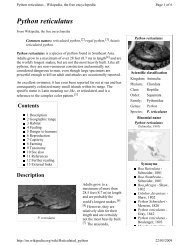Issue Thirteen 30 June 2012 - Taxonomic issue - all - Smuggled.com
Issue Thirteen 30 June 2012 - Taxonomic issue - all - Smuggled.com
Issue Thirteen 30 June 2012 - Taxonomic issue - all - Smuggled.com
You also want an ePaper? Increase the reach of your titles
YUMPU automatically turns print PDFs into web optimized ePapers that Google loves.
10<br />
Australasian Journal of Herpetology ISSN 1836-5698 (Print)<br />
Australasian Journal of Herpetology 13:10-14.<br />
ISSN 1836-5779 (Online)<br />
Published <strong>30</strong> <strong>June</strong> <strong>2012</strong>.<br />
A three-way division of the African Centipede<br />
Eating Snakes, Apar<strong>all</strong>actus Smith, 1849 (Serpentes:<br />
Lamprophiidae: Apar<strong>all</strong>actinae) and a new subgenus of<br />
Wolf Snakes Lycophidion Fitzinger, 1843<br />
(Serpentes: Lamprophiidae, Lamprophiinae).<br />
INTRODUCTION<br />
The Centipede Eating Snakes, genus Apar<strong>all</strong>actus Smith, 1849<br />
as currently recognized consists of a genus of rear-fanged<br />
snakes found in Africa.<br />
The taxonomic history of the group is similar to that of many<br />
other snake genera.<br />
In the 1800’s when species were named, many were placed in<br />
new genera at the time of first description.<br />
In the 1900’s these genera have been merged with the senior<br />
name taking priority.<br />
In the post 2000 period a number of snake genera have been<br />
revisited to see if it is in fact appropriate to have morphologic<strong>all</strong>y<br />
conservative species within a single genus.<br />
When it has been deemed appropriate to split a genus up, a<br />
search for pre-existing “available” names is done and if such are<br />
available, then these are used. If not, then one is assigned.<br />
Raymond T. Hoser<br />
488 Park Road, Park Orchards, Victoria, 3134, Australia.<br />
Phone: +61 3 9812 3322 Fax: 9812 3355 E-mail: viper007@live.<strong>com</strong>.au<br />
Received 26 March <strong>2012</strong>, Accepted 12 April <strong>2012</strong>, Published <strong>30</strong> <strong>June</strong> <strong>2012</strong>.<br />
ABSTRACT<br />
A review of the Centipede Eating Snakes, Apar<strong>all</strong>actus Smith, 1849 shows that the genus<br />
as understood at present <strong>com</strong>prises three well-defined species groups. On this basis the<br />
genus Apar<strong>all</strong>actus Smith, 1849 is divided three ways.<br />
Most species remain within Apar<strong>all</strong>actus. The species modestus is placed on its own in<br />
the genus Elapops Günther, 1859.<br />
Two species, Apar<strong>all</strong>actus werneri Boulenger, 1895 and Apar<strong>all</strong>actus nigriceps (Peters,<br />
1854), are placed in a new genus Plumridgeus gen. nov. which is named and diagnosed<br />
according to the Zoological Code.<br />
Within the African Wolf Snake genus Lycophidion Fitzinger, 1843 one species is divergent<br />
from the rest and is placed within its own subgenus, namely Jacobclarkus subgen. nov..<br />
Keywords: <strong>Taxonomic</strong> revision; new genus; new subgenus; Apar<strong>all</strong>actus; Plumridgeus;<br />
Lycophidion; Jacobclarkus; Elapops; Metoporhina; Cryptolycus; capensis; modestus;<br />
werneri; nigriceps; laterale.<br />
Apar<strong>all</strong>actus has also been the subject of molecular studies that<br />
have shown phylogenetic divisions within the genus as currently<br />
understood worthy of recognition at the genus level.<br />
Pyron et. al. (2011) published results for three species showing<br />
at least two species groups within Apar<strong>all</strong>actus worthy of generic<br />
recognition.<br />
A review of the entire 11 species currently placed within<br />
Apar<strong>all</strong>actus has found three distinct groups worthy of generic<br />
recognition.<br />
These are easily characterized as follows:<br />
The first group consists of most species, including the type<br />
species capensis. These snakes typic<strong>all</strong>y have seven<br />
supralabials and a high subcaudal count and in line with their<br />
<strong>com</strong>mon name, typic<strong>all</strong>y feed on centipedes.<br />
The second group is that of the divergent species, modestus<br />
which while physic<strong>all</strong>y similar to the snakes in the first group,<br />
Available online at www.herp.net<br />
Copyright- Kotabi Publishing - All rights reserved<br />
Hoser <strong>2012</strong> - Australasian Journal of Herpetology 13:10-14.



